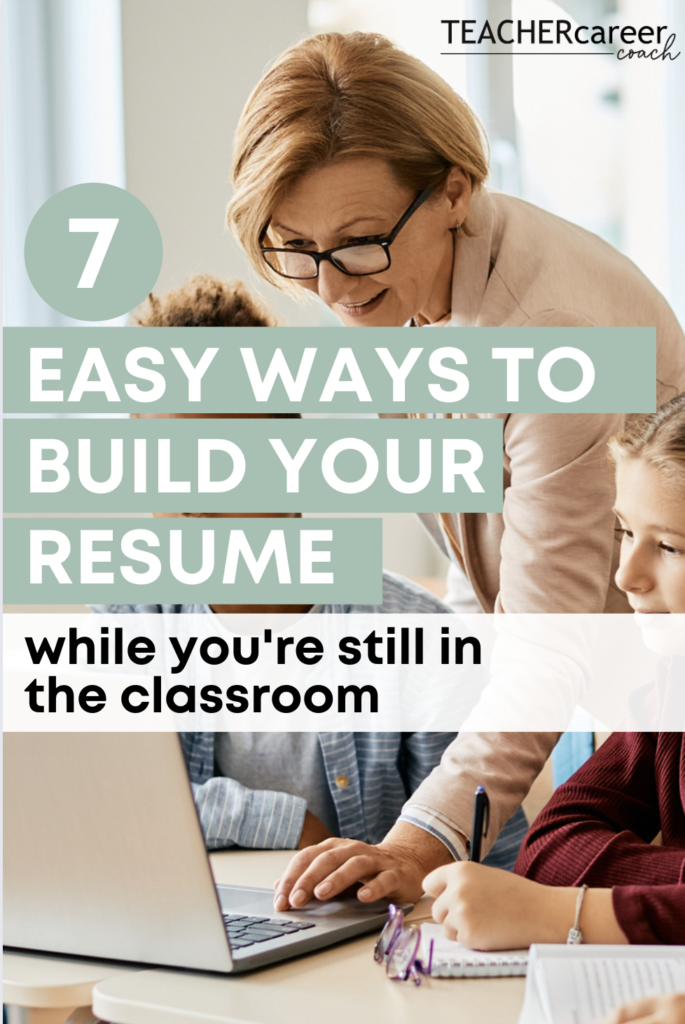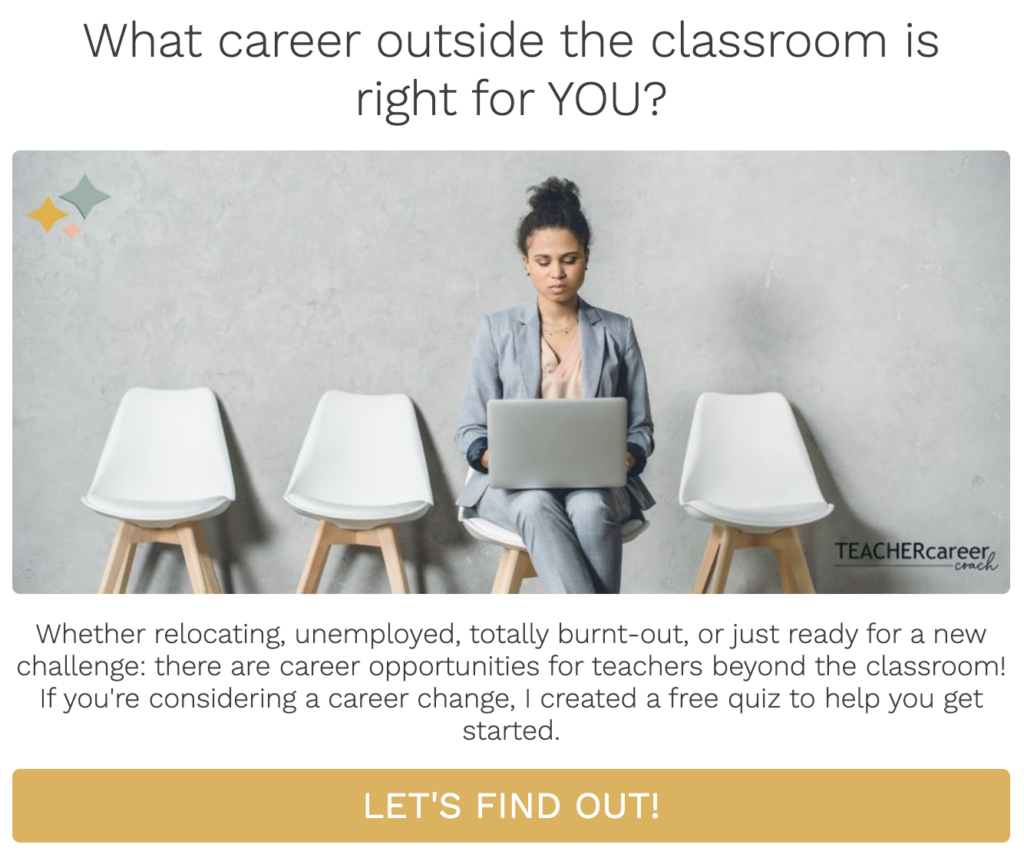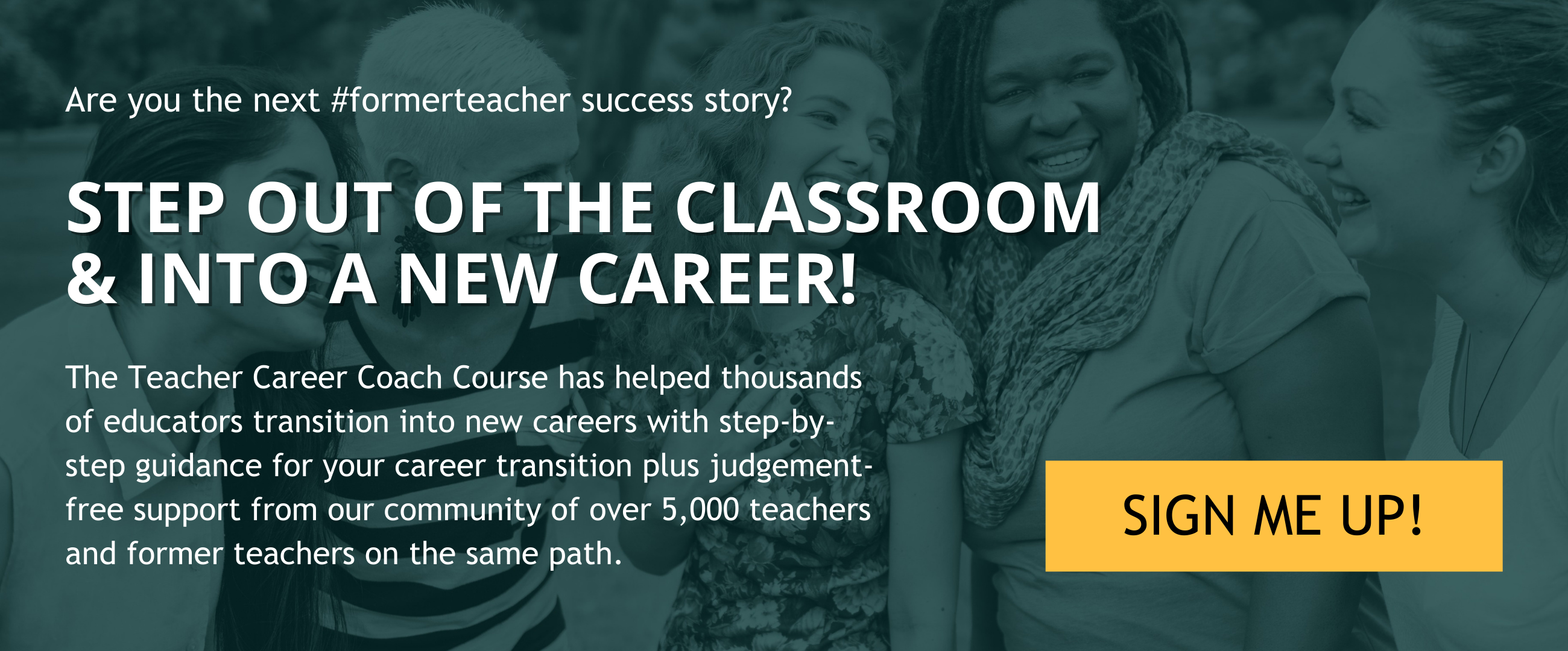In this post, I’m going to outline seven ways to build your teacher resume experience while you are still in the classroom. It is incredibly important to quantify your resume and really show how your skills and experience apply to your chosen career path. This might mean focusing on building new skills or amplifying experience that you already have.
Making a career change is never easy, and teachers have an especially limited amount of time and energy to dedicate to career hunting during the school year. But difficult does not mean impossible!

7 Ways to Build & Showcase Skills & Experience on Your Teacher Transition Resume
One important step to getting your foot in the door is having a professional resume that highlights your skills and experience as a teacher. Many teachers make the misstep of focusing solely on the soft skills that “all teachers have,” such as organizational, planning, and presentation skills.
Below are seven ways that you can begin to build your resume experience while you’re still teaching. Some of these recommendations will require more time to dedicate, while others can be incorporated into your regular routine – and might even help you work more efficiently this year.
1. Showcase Your Teacher Experience by Tracking Your Accomplishments for Your Resume
We see teachers underestimate their accomplishment so frequently, that I knew I needed to make this the very first tip. There is so much that goes into teaching, beyond planning and delivering lessons to students. Use your resume to highlight these experience and accomplishments.
Make sure to highlight leadership roles such as Grade Level lead, leading PLC meetings, and any training you do with adults – whether that be formal Personal Development or informal tech training one-on-one with a colleague or your team.
2. Keep Track of Data to Quantify Your Skills
Along with highlighting your accomplishments, you will want to quantify these experiences on your resume. This can sometimes be a challenge, so it’s important to track these accomplishments as you go. In many careers, quantifiable goals are key, and highlighting your experience with data can help you impress a hiring manager. Here’s an example of how that may look on your resume:
Example of vaguely stating experience:
Led PLC Meetings
Example of Quantifying Experience:
Chaired Professional Learning Community for a team of seven faculty members weekly for 2 years, responsible for monitoring goals, motivating teammates, and inspiring positive, professional collaboration
3. Volunteer for Roles that Align with Your Chosen Career Path
The difficulty for some teachers, especially newer teachers looking to transition into a new career, is a lack of opportunity. Sometimes these leadership roles or chairs fall to other, more experienced teachers. “Volunteers” are often selected. If you feel passed over for these opportunities, it may be time to step up and volunteer for these roles.
Volunteering to help you team by creating grade level or individual websites, creating materials for your team, or sitting on/chairing a committee is one way to get started. You may also have opportunities to represent your grade level throughout the year at training events, PDs, or at PTO meetings, for example.
Volunteering in your own school is a great way to build your teacher resume experience, but there also may be chances to volunteer outside of your school setting. Look for roles that align with your desired career path. You may find opportunities in your community or for local or online businesses that can help you diversify your skills.
4. Build Your Teacher Resume with Experience Using Software & Tools in the Classroom
Another way to build your resume while still in the classroom is to use free or low-cost software traditionally used in businesses in your classroom. Working to master these programs to create lesson plans or presentations, organize your work, and collaborate with your team is a time-efficient way to upskill and may help you to work more effectively. Check out what types of programs are traditionally used in your chosen career path. Can you incorporate these into your teaching routine? A few suggestions:
- Trello or Asana: These programs are used by businesses to help teams organize their work flow and collaborate. They are free to use and a great way to share lessons, files, and shared tasks.
- Canva: This free program is a great way to step into creating your own classroom materials and presentations and is used by many businesses for designing online and print materials and reusable templates.
- Website & Online Classroom Tools: Your school likely has purchased dedicated programs for online teaching and website creation. Some schools use Google Classroom, for example. Take a look at different ways you can incorporate these tools for use in your classroom. You may be able to find additional free training for how to use these in school and business as well.
5. Explore Freelance, Part-time, or Summer Work
You can build your skills outside the classroom as well. There are opportunities for entry-level work where you can both gain experience and make extra cash on the side. Remote positions such as Pinterest management, virtual assistant jobs, copywriting, and editing are just a few examples of jobs where you can work on building skills that will be applicable for the next step of your career while fluffing up your resume.
Part-time, freelance, or temporary positions that are aligned with your future career path can be important stepping stones. You will need time to dedicate to make these gigs successful, but many teachers in our audience have shared that these stepping stone jobs helped them land their first full-time job outside the classroom. And a few have even gone on to make these opportunities full-time careers.
Find more ideas here: EP 54 – Micala Quinn: Top Freelancing Jobs for Teachers
6. Upskill with an Online Training or Bootcamp in Your Chosen Field
If you have less time to dedicate to building your skillset, upskilling with online courses is an option. Again, make sure that the classes you take are fully aligned with the job(s) for which you are applying when you add them to your resume!
Taking online courses is a great way to dip your toes into a variety of jobs and see which is best suited for you. However, it is not necessary to list every online course you’ve dipped into! Tweak your resume to highlight the courses that you’ve taken that directly apply to the position.
For more information about upskilling and course recommendations check out the blog post Upskill and Reskill: Online Courses for Your Career Transition.
7. Translate Your Teacher Skills & Experience on Your Resume
Finally, it is important to take a look at the skills and experience you already have. Your current teaching experience will translate to your resume. Teachers often see job postings without realizing how the requirements meet their experience. For example, if you see a customer-facing trainer position – think of your classroom as the clients and you as the trainer.
Sometimes thinking this way may feel like a stretch, but ultimately it’s how your skills translate into corporate lingo. You most likely have skills you’ve never ever thought of. Practicing this career-ready mindset is essential when you are looking to transition out of the classroom. That way, when you interview, you convey the confidence that you are capable of doing the job at hand. Here’s an example:
Teacher Resume:
Organized and coordinated events for students and parents annually
Corporate Translation:
Planned, coordinated, and executed 15 annual events for over 500 attendees per event, including vendor management, marketing promotions, and event itineraries
Related: Transferable Skills Teachers Have: 4 Tips for Translating Your Resume
More Help for Your Teacher Transition Resume
If you found this article helpful, we have a fully comprehensive resource that will take you step-by-step through translating your skills and building a professional resume.
The Teacher Career Coach Course includes:
- 20 pages of teacher-to-corporate language translations
- Guidance on how to format your resume
- Complete teacher transition resume examples
- How to make your resume ATS friendly – so it actually gets read by applicant tracking systems and into the hands of a hiring manager!
- A tried-and-true template to get you started
Through The Teacher Career Coach course, we have helped thousands of teachers successfully pivot into a new career. Click below to join our course and instantly access a community like-minded educators and the tools you need to transition out of the classroom and into a new career.


